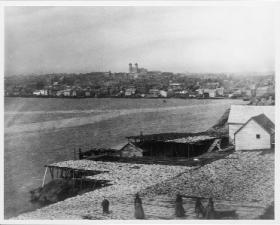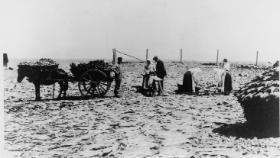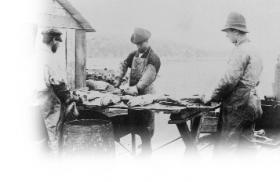Museum Eye
Published in Issue 1 (Jan/Feb 2005), Reviews, Volume 13Celebrating transatlantic Waterford —the Waterford–Newfoundland connection
Waterford Museum of Treasures
The Granary, Merchant’s Quay
April–Sept.: Mon.–Sat. 9.30am–6pm; Sun. 11am–6pm
Oct.–March: Mon.–Fri. 10am–5pm; Sat. and Sun. 11am–5pm
by Johanne Devlin Frew

St John’s, Newfoundland. Note the Catholic basilica of St John the Baptist on the brow of the hill. (Provincial Archives of Newfoundland and Labrador)
The link between Ireland and Newfoundland is unique in the Irish diaspora. Given that the Irish comprised 40 per cent of its population by 1750 and 50 per cent by 1850, and that Newfoundland has not experienced significant immigration from other countries in the century and a half since, the retention of Irish cultural traits is nowhere more evident. It is therefore surprising that Newfoundland has not received more attention from historians of Ireland and its diaspora. To scholars of oral tradition, however, Newfoundland has long been recognised for its distinctive traditions in song, music and folklore, although even much of this remains unexplored, particularly from an Irish perspective.
While much has been researched and written about Newfoundland’s connection with south-west England, the story of the Irish in Newfoundland and the Irish influence on the development of Newfoundland’s distinct culture has remained the domain of only a few scholars, most notably Galway native and historical geographer John Mannion of Memorial University. Mannion’s remarkable work includes a lifetime of detailed research gathered about Irish Newfoundland families and communities, maritime trade routes and the economics of the Newfoundland fishery. While many Newfoundlanders are themselves cognisant of the strong link with Ireland, what has been largely lacking to date in the research is the input of more scholars adequately familiar with the Irish context.
Consequently, this exhibit, opened in June 2004 by President Mary McAleese, is very welcome indeed, and especially appropriate in view of the official twinning of Waterford with St John’s in 2002. It is a joint initiative of the museum and the Ireland Newfoundland Partnership, itself an initiative stemming from the memorandum of understanding between the Irish government and the government of Newfoundland and Labrador, first signed in 1996 and since reaffirmed in 1999 and 2004.
The Waterford Museum of Treasures houses an impressive collection of artefacts depicting the history of the Waterford region and organised in roughly chronological sequence as one moves through the museum from lower to upper floors. The Newfoundland exhibit is located in a corner of the top floor in a small area of 4m by 9m. There are essentially three components to the exhibit: wall panels of photographs and a map of the world showing Ireland and Newfoundland; artefacts contained in three small exhibition cases; and a set of short videos shown on a large screen.

Not Connemara, Co. Galway, but a pony and creel collecting dried fish near St John’s. (Provincial Archives of Newfoundland and Labrador)
The collection of over 50 black-and-white photographs along the wall depicts life in Newfoundland during the nineteenth and early twentieth centuries, many of them showing fishing stages and premises and the preparation of salt cod, while others are of small outport communities. The artefacts are a rather odd collection of items dating from the same period, the most interesting being an urn given to the first Catholic bishop of Newfoundland, James Louis O’Donel (1737–1811), originally from County Tipperary, upon his retirement in 1807 ‘as testimony of their esteem for his pious, patriotic and meritorious conduct during a residence among them of twenty-three years’. A second exhibition case contains four items pertaining to the fishery: a tinder-box for making fire on board ship, with a pattern reflecting the decorative tradition of south-east Ireland; two barrel stencils to mark barrels of codfish; and a cod-jigger. The third case contains domestic artefacts: a berry-picker, a cutlery box and a pair of carders.
The main focus of the exhibit is the series of short videos, 25 in total, organised into five categories: migration and settlement; fishery and provisions; politics and religion; women; and culture. Each category has an introduction, followed by four short films, all covering a different aspect of the topic. Categories are organised in such a way that they move from a general perspective to a particular human story: so, for example, the section on fishery and provisions begins with a general introduction and continues through the specifics of the trade, the Irish role in it and the connection with Waterford, finishing with a profile of the Penrose family of merchants. The section on migration and settlement situates the Irish within the context of other settlers, then examines their particular type of settlement, and ends with a profile of Thomas Meagher (1789–1874), Newfoundland-born mayor of Waterford and father of the famous Thomas Francis Meagher (1823–66). To play the film segments, viewers select them on the wall panel; they can therefore control which segments they wish to watch and in which order. The style of the production is that of historical film footage and still photographs voiced over by a narrator from a script that includes excerpts from letters and diaries read in other voices. Pronunciation is not always faithful. For example, the small feeder fish caplin, a mainstay of Newfoundland life, is pronounced ‘cap-lin’ rather than ‘cape-lin’, as in Newfoundland usage.

Splitting codfish. (Centre for Newfoundland Studies Archives)
When I visited the museum (August 2004), accompanied by two Newfoundlanders, we were all particularly interested in the culture category, the segments of which are entitled ‘Religious and folk customs’, ‘Language and accent’, ‘Family and place names’, and ‘Donncha Rua Mac Conmara (1715–1810)’. While delighted to view the profile of the Déise poet included, we were disappointed that there wasn’t a more recent account of Newfoundland’s vibrant musical culture, or a feature on its brilliant community of writers and artists. It is the perspective of the twenty-first century that is lacking in the exhibit—how the ‘colony of Waterford’ continues to thrive and develop in Newfoundland life, politics and culture to the present day.
On a very positive note, the museum is actively monitoring the response to the exhibit and, as explained by curator Eamonn McEneaney, they have already improved the video feature, which was originally operated by stepping on special tiles in the floor but which, as viewers stepped on one tile on the way to another, was prone to malfunction. This perhaps points to the challenges of representation here, which, owing to the lack of artefacts, is based almost entirely on the film segments. While the video overall is very informative and appealing, it is a bit long, with each segment averaging five minutes (approximately 25–30 minutes in total), and it is unlikely that the average guest would sit through all of this, especially if accompanied by children. We left the exhibit wanting more but delighted nonetheless that Newfoundland once again has a presence in Waterford.
Johanne Devlin Frew is a research fellow at the Centre for Migration Studies and the School of History, Queen’s University, Belfast.
















